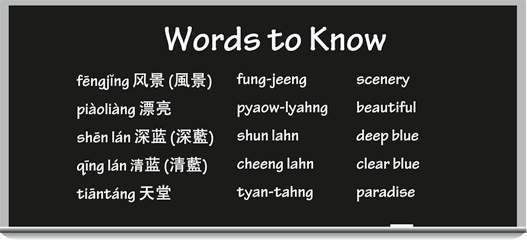Chinese For Dummies (91 page)
Read Chinese For Dummies Online
Authors: Wendy Abraham
 shù
shù
æ
(
樹
) (shoo) (
trees
)
 xiÇo shÄn
xiÇo shÄn
å°å±±
(shyaow-shahn) (
hills
)
 yún
yún
äº
(
é²
) (yewn) (
clouds
)
 Â China's sacred mountains
 China's sacred mountains
Both Buddhists and Daoists have traditionally built monasteries high on quiet mountaintops or deep inside lush forests to meditate. Some of China's
shÄn
å±±
(shahn) (
mountains
) â five Daoist and four Buddhist â are still considered sacred today, and they all remain sites of pilgrimage.
Huáng ShÄn
é»å±±
(hwahng shahn) (
Yellow Mountain
) is perhaps China's most famous sacred mountain; it's distinguished by rare pine trees, unusual rock formations, and hot springs and surrounded by lakes and waterfalls.
Talkin' the Talk
 Herman and Serena discover the beauty of the seaside resort of
Herman and Serena discover the beauty of the seaside resort of
BÄidà ihé
(bay-dye-huh) in northern China. (Track 16)
Herman:
NÇ kà n! Zhèr de fÄngjÇng duÅme pià olià ng!
nee kahn! jar duh fung-jeeng dwaw-muh pyaow-lyahng!
Look! The scenery here is gorgeous!
(Literally:
How gorgeous the scenery here is!
)
Serena:
NÇ shuÅ duìle. ZhÄn pià olià ng.
nee shwaw dway-luh. jun pyaow-lyahng.
You're right. It's truly beautiful.
Herman:
Shénme dÅu yÇu: shÄn, shÄn lán de hÇi, qÄ«ng lán de tiÄn.
shummuh doe yo: shahn, shun lahn duh hi, cheeng lahn duh tyan.
It has everything: mountains, deep blue ocean, and clear sky.
Serena:
NÇ shuÅ duìle. Xià ng tiÄntáng yÃyà ng.
nee shwaw dway-luh. shyahng tyan-tahng ee-yahng.
You're right. It's like paradise.

 To indicate a similarity between two ideas or objects, as in the last line of the Talkin' the Talk involving Serena and Herman, use the phrase
To indicate a similarity between two ideas or objects, as in the last line of the Talkin' the Talk involving Serena and Herman, use the phrase
xià ng . . . yÃyà ng
å . . . ä¸æ ·. (å . . . ä¸æ¨£.)
(shyahng . . . ee yahng.). Here are some examples:
xià ng nÇ dìdì yÃyà ng
åä½ å¼å¼ä¸æ ·
(
åä½ å¼å¼ä¸æ¨£
) (shyahng nee dee-dee ee-yahng) (
like your younger brother)
xià ng qÄ«ngwÄ yÃyà ng
åéèä¸æ ·
(
åéèä¸æ¨£
) (shyahng cheeng-wah ee-yahng) (
like a frog
)
xià ng
fÄngzi yÃyà ng
åç¯åä¸æ ·
(
åçåä¸æ¨£
) (shyahng fung-dzuh ee-yahng) (
like a crazy person
)
 Â The Shanghai Children's Palace
 The Shanghai Children's Palace
If you ever visit Shanghai, make time for a visit to the
Shà oniángÅng
å°å¹´å®«
(shaow-nyan-goong) (
the Children's Palace
), where gifted children take part in an assortment of extracurricular activities in areas such as music, art, dance, and science. Founded in 1953 by Song Qingling (whose husband, Dr. Sun Yat-sen, established the Republic of China, or Taiwan) the Children's Palace is in a grand old building originally known as Marble Hall. It was built by the Baghdadi Jewish tycoon Elly Kadoorie in 1924 and still boasts grand marble hallways, winding staircases, ornate fireplaces, chandeliers, and French windows.
 Today you can find such activities as hot-air ballooning and gliding in Anyang. Kind of amazing when you discover Anyang was the capital of China's very first dynasty, almost two millennia before the Common Era. You can even hook up with a hot-air balloon tour of the Great Wall and the Silk Road. These pursuits certainly present a good way to cover such great distances without requiring you to have been a Hun on horseback. Speaking of which, if camel treks are your thing, Chinese travel agencies can now even arrange for you to ride with the Mongols, those horsemen who've perfected the art of riding over the centuries.
Today you can find such activities as hot-air ballooning and gliding in Anyang. Kind of amazing when you discover Anyang was the capital of China's very first dynasty, almost two millennia before the Common Era. You can even hook up with a hot-air balloon tour of the Great Wall and the Silk Road. These pursuits certainly present a good way to cover such great distances without requiring you to have been a Hun on horseback. Speaking of which, if camel treks are your thing, Chinese travel agencies can now even arrange for you to ride with the Mongols, those horsemen who've perfected the art of riding over the centuries.
Tapping into Your Artistic Side
You may pride yourself on having been the biggest jock, but I bet you still get teary-eyed when you see a beautiful painting or listen to Beethoven. It's okay, just admit it. You're a regular Renaissance man and you can't help it. No more apologies.
Okay, now you're ready to tap into your more sensitive, artistic side in Chinese. Don't be afraid of expressing your
gÇnqÃng
ææ
(gahn-cheeng) (
emotions
). The Chinese will appreciate your sensitivity to a
shÄnshuÇ huÃ
山水ç»
(
山水ç«
)
(shahn-shway hwah) (
landscape painting
) from the
Sòng
å®
(soong) dynasty (960â1279) or to the beauty of a
cÃqì
ç·å¨
(tsuh-chee) (
porcelain
) from the
MÃng
æ
(meeng) dynasty (1368â1644).